Leadership Theories and Skills
VerifiedAdded on 2020/01/16
|21
|7025
|192
Essay
AI Summary
This essay critically evaluates leadership theories, focusing on contingency and trait theories. It examines their application in various organizational contexts, using PepsiCo as a case study. The essay explores the strengths and weaknesses of each theory, highlighting the importance of adapting leadership styles to different situations. It also delves into essential leadership skills and competencies, including self-management, people management, project management, and ethical considerations. The essay concludes by emphasizing the need for leaders to develop a diverse skillset and adapt their approach to achieve organizational success.
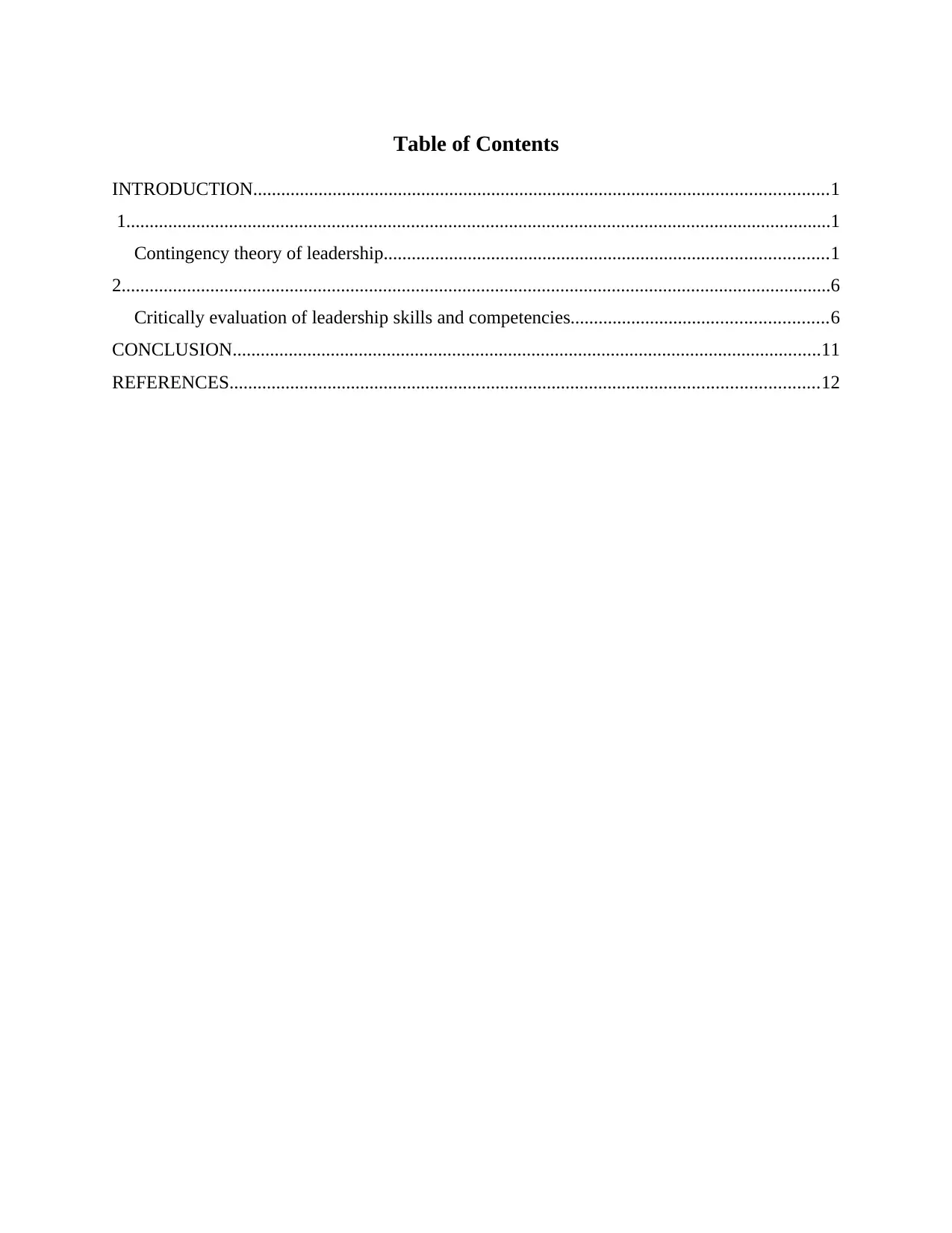
Table of Contents
INTRODUCTION...........................................................................................................................1
1.......................................................................................................................................................1
Contingency theory of leadership...............................................................................................1
2........................................................................................................................................................6
Critically evaluation of leadership skills and competencies.......................................................6
CONCLUSION..............................................................................................................................11
REFERENCES..............................................................................................................................12
INTRODUCTION...........................................................................................................................1
1.......................................................................................................................................................1
Contingency theory of leadership...............................................................................................1
2........................................................................................................................................................6
Critically evaluation of leadership skills and competencies.......................................................6
CONCLUSION..............................................................................................................................11
REFERENCES..............................................................................................................................12
Paraphrase This Document
Need a fresh take? Get an instant paraphrase of this document with our AI Paraphraser
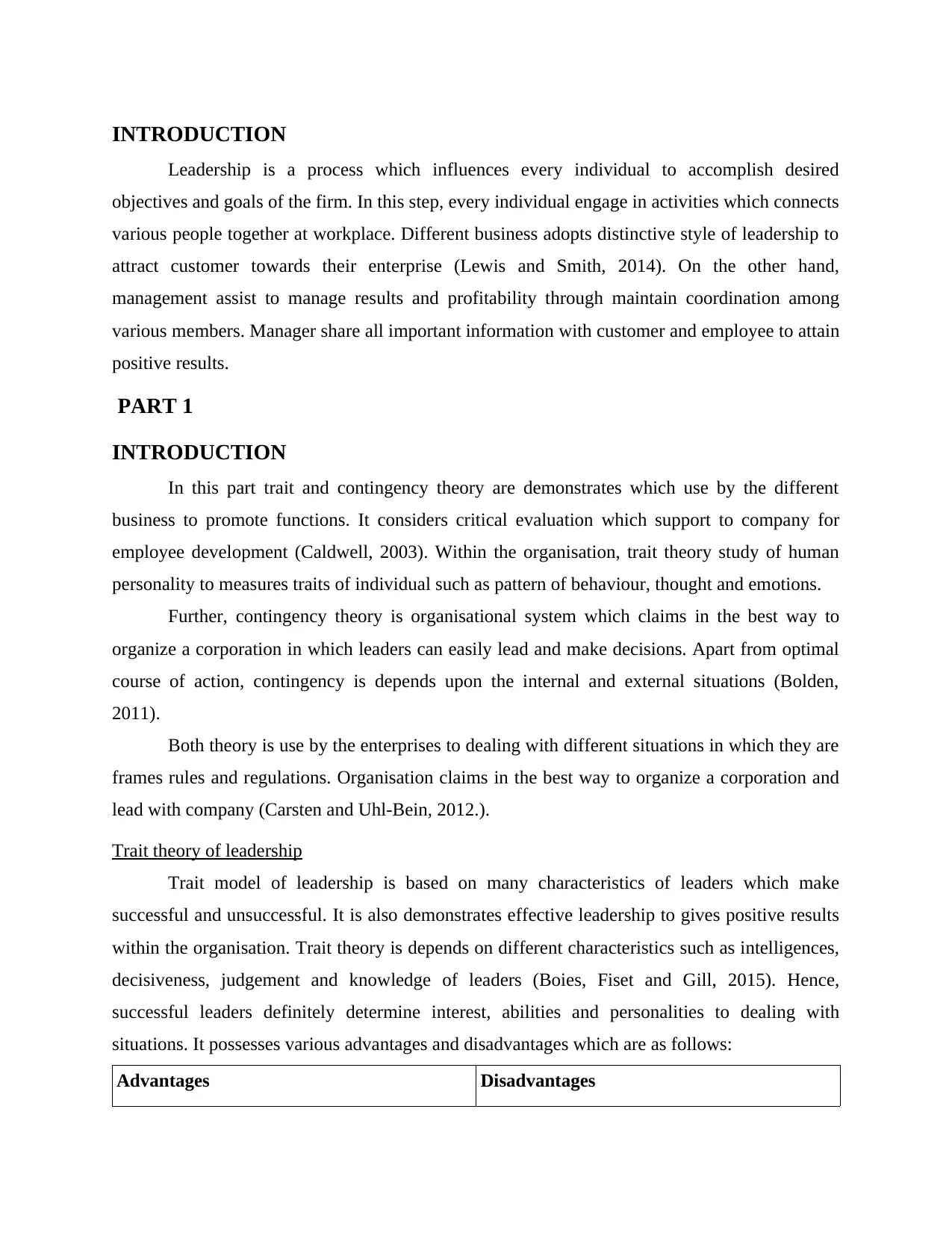
INTRODUCTION
Leadership is a process which influences every individual to accomplish desired
objectives and goals of the firm. In this step, every individual engage in activities which connects
various people together at workplace. Different business adopts distinctive style of leadership to
attract customer towards their enterprise (Lewis and Smith, 2014). On the other hand,
management assist to manage results and profitability through maintain coordination among
various members. Manager share all important information with customer and employee to attain
positive results.
PART 1
INTRODUCTION
In this part trait and contingency theory are demonstrates which use by the different
business to promote functions. It considers critical evaluation which support to company for
employee development (Caldwell, 2003). Within the organisation, trait theory study of human
personality to measures traits of individual such as pattern of behaviour, thought and emotions.
Further, contingency theory is organisational system which claims in the best way to
organize a corporation in which leaders can easily lead and make decisions. Apart from optimal
course of action, contingency is depends upon the internal and external situations (Bolden,
2011).
Both theory is use by the enterprises to dealing with different situations in which they are
frames rules and regulations. Organisation claims in the best way to organize a corporation and
lead with company (Carsten and Uhl-Bein, 2012.).
Trait theory of leadership
Trait model of leadership is based on many characteristics of leaders which make
successful and unsuccessful. It is also demonstrates effective leadership to gives positive results
within the organisation. Trait theory is depends on different characteristics such as intelligences,
decisiveness, judgement and knowledge of leaders (Boies, Fiset and Gill, 2015). Hence,
successful leaders definitely determine interest, abilities and personalities to dealing with
situations. It possesses various advantages and disadvantages which are as follows:
Advantages Disadvantages
Leadership is a process which influences every individual to accomplish desired
objectives and goals of the firm. In this step, every individual engage in activities which connects
various people together at workplace. Different business adopts distinctive style of leadership to
attract customer towards their enterprise (Lewis and Smith, 2014). On the other hand,
management assist to manage results and profitability through maintain coordination among
various members. Manager share all important information with customer and employee to attain
positive results.
PART 1
INTRODUCTION
In this part trait and contingency theory are demonstrates which use by the different
business to promote functions. It considers critical evaluation which support to company for
employee development (Caldwell, 2003). Within the organisation, trait theory study of human
personality to measures traits of individual such as pattern of behaviour, thought and emotions.
Further, contingency theory is organisational system which claims in the best way to
organize a corporation in which leaders can easily lead and make decisions. Apart from optimal
course of action, contingency is depends upon the internal and external situations (Bolden,
2011).
Both theory is use by the enterprises to dealing with different situations in which they are
frames rules and regulations. Organisation claims in the best way to organize a corporation and
lead with company (Carsten and Uhl-Bein, 2012.).
Trait theory of leadership
Trait model of leadership is based on many characteristics of leaders which make
successful and unsuccessful. It is also demonstrates effective leadership to gives positive results
within the organisation. Trait theory is depends on different characteristics such as intelligences,
decisiveness, judgement and knowledge of leaders (Boies, Fiset and Gill, 2015). Hence,
successful leaders definitely determine interest, abilities and personalities to dealing with
situations. It possesses various advantages and disadvantages which are as follows:
Advantages Disadvantages
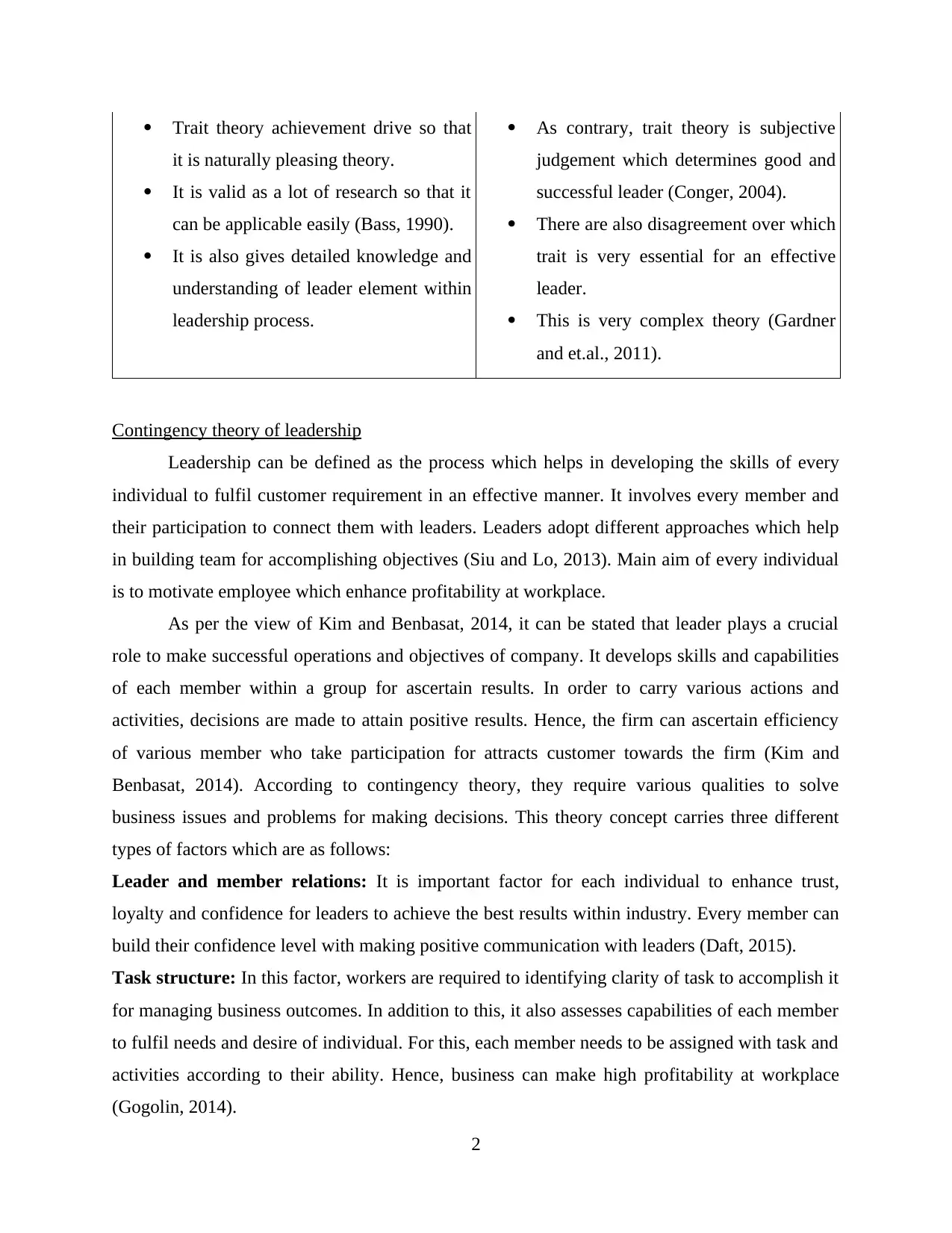
Trait theory achievement drive so that
it is naturally pleasing theory.
It is valid as a lot of research so that it
can be applicable easily (Bass, 1990).
It is also gives detailed knowledge and
understanding of leader element within
leadership process.
As contrary, trait theory is subjective
judgement which determines good and
successful leader (Conger, 2004).
There are also disagreement over which
trait is very essential for an effective
leader.
This is very complex theory (Gardner
and et.al., 2011).
Contingency theory of leadership
Leadership can be defined as the process which helps in developing the skills of every
individual to fulfil customer requirement in an effective manner. It involves every member and
their participation to connect them with leaders. Leaders adopt different approaches which help
in building team for accomplishing objectives (Siu and Lo, 2013). Main aim of every individual
is to motivate employee which enhance profitability at workplace.
As per the view of Kim and Benbasat, 2014, it can be stated that leader plays a crucial
role to make successful operations and objectives of company. It develops skills and capabilities
of each member within a group for ascertain results. In order to carry various actions and
activities, decisions are made to attain positive results. Hence, the firm can ascertain efficiency
of various member who take participation for attracts customer towards the firm (Kim and
Benbasat, 2014). According to contingency theory, they require various qualities to solve
business issues and problems for making decisions. This theory concept carries three different
types of factors which are as follows:
Leader and member relations: It is important factor for each individual to enhance trust,
loyalty and confidence for leaders to achieve the best results within industry. Every member can
build their confidence level with making positive communication with leaders (Daft, 2015).
Task structure: In this factor, workers are required to identifying clarity of task to accomplish it
for managing business outcomes. In addition to this, it also assesses capabilities of each member
to fulfil needs and desire of individual. For this, each member needs to be assigned with task and
activities according to their ability. Hence, business can make high profitability at workplace
(Gogolin, 2014).
2
it is naturally pleasing theory.
It is valid as a lot of research so that it
can be applicable easily (Bass, 1990).
It is also gives detailed knowledge and
understanding of leader element within
leadership process.
As contrary, trait theory is subjective
judgement which determines good and
successful leader (Conger, 2004).
There are also disagreement over which
trait is very essential for an effective
leader.
This is very complex theory (Gardner
and et.al., 2011).
Contingency theory of leadership
Leadership can be defined as the process which helps in developing the skills of every
individual to fulfil customer requirement in an effective manner. It involves every member and
their participation to connect them with leaders. Leaders adopt different approaches which help
in building team for accomplishing objectives (Siu and Lo, 2013). Main aim of every individual
is to motivate employee which enhance profitability at workplace.
As per the view of Kim and Benbasat, 2014, it can be stated that leader plays a crucial
role to make successful operations and objectives of company. It develops skills and capabilities
of each member within a group for ascertain results. In order to carry various actions and
activities, decisions are made to attain positive results. Hence, the firm can ascertain efficiency
of various member who take participation for attracts customer towards the firm (Kim and
Benbasat, 2014). According to contingency theory, they require various qualities to solve
business issues and problems for making decisions. This theory concept carries three different
types of factors which are as follows:
Leader and member relations: It is important factor for each individual to enhance trust,
loyalty and confidence for leaders to achieve the best results within industry. Every member can
build their confidence level with making positive communication with leaders (Daft, 2015).
Task structure: In this factor, workers are required to identifying clarity of task to accomplish it
for managing business outcomes. In addition to this, it also assesses capabilities of each member
to fulfil needs and desire of individual. For this, each member needs to be assigned with task and
activities according to their ability. Hence, business can make high profitability at workplace
(Gogolin, 2014).
2
⊘ This is a preview!⊘
Do you want full access?
Subscribe today to unlock all pages.

Trusted by 1+ million students worldwide
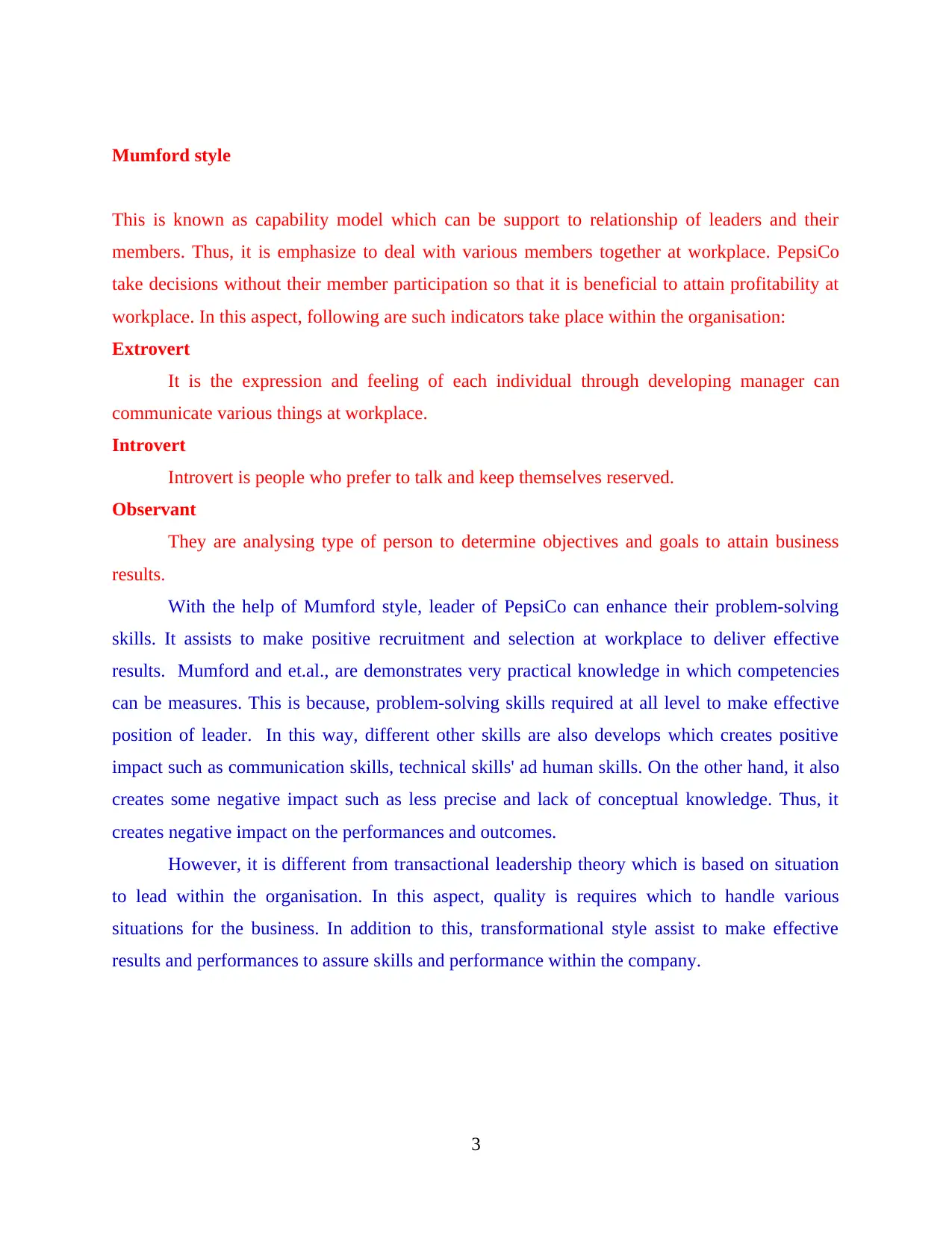
Mumford style
This is known as capability model which can be support to relationship of leaders and their
members. Thus, it is emphasize to deal with various members together at workplace. PepsiCo
take decisions without their member participation so that it is beneficial to attain profitability at
workplace. In this aspect, following are such indicators take place within the organisation:
Extrovert
It is the expression and feeling of each individual through developing manager can
communicate various things at workplace.
Introvert
Introvert is people who prefer to talk and keep themselves reserved.
Observant
They are analysing type of person to determine objectives and goals to attain business
results.
With the help of Mumford style, leader of PepsiCo can enhance their problem-solving
skills. It assists to make positive recruitment and selection at workplace to deliver effective
results. Mumford and et.al., are demonstrates very practical knowledge in which competencies
can be measures. This is because, problem-solving skills required at all level to make effective
position of leader. In this way, different other skills are also develops which creates positive
impact such as communication skills, technical skills' ad human skills. On the other hand, it also
creates some negative impact such as less precise and lack of conceptual knowledge. Thus, it
creates negative impact on the performances and outcomes.
However, it is different from transactional leadership theory which is based on situation
to lead within the organisation. In this aspect, quality is requires which to handle various
situations for the business. In addition to this, transformational style assist to make effective
results and performances to assure skills and performance within the company.
3
This is known as capability model which can be support to relationship of leaders and their
members. Thus, it is emphasize to deal with various members together at workplace. PepsiCo
take decisions without their member participation so that it is beneficial to attain profitability at
workplace. In this aspect, following are such indicators take place within the organisation:
Extrovert
It is the expression and feeling of each individual through developing manager can
communicate various things at workplace.
Introvert
Introvert is people who prefer to talk and keep themselves reserved.
Observant
They are analysing type of person to determine objectives and goals to attain business
results.
With the help of Mumford style, leader of PepsiCo can enhance their problem-solving
skills. It assists to make positive recruitment and selection at workplace to deliver effective
results. Mumford and et.al., are demonstrates very practical knowledge in which competencies
can be measures. This is because, problem-solving skills required at all level to make effective
position of leader. In this way, different other skills are also develops which creates positive
impact such as communication skills, technical skills' ad human skills. On the other hand, it also
creates some negative impact such as less precise and lack of conceptual knowledge. Thus, it
creates negative impact on the performances and outcomes.
However, it is different from transactional leadership theory which is based on situation
to lead within the organisation. In this aspect, quality is requires which to handle various
situations for the business. In addition to this, transformational style assist to make effective
results and performances to assure skills and performance within the company.
3
Paraphrase This Document
Need a fresh take? Get an instant paraphrase of this document with our AI Paraphraser
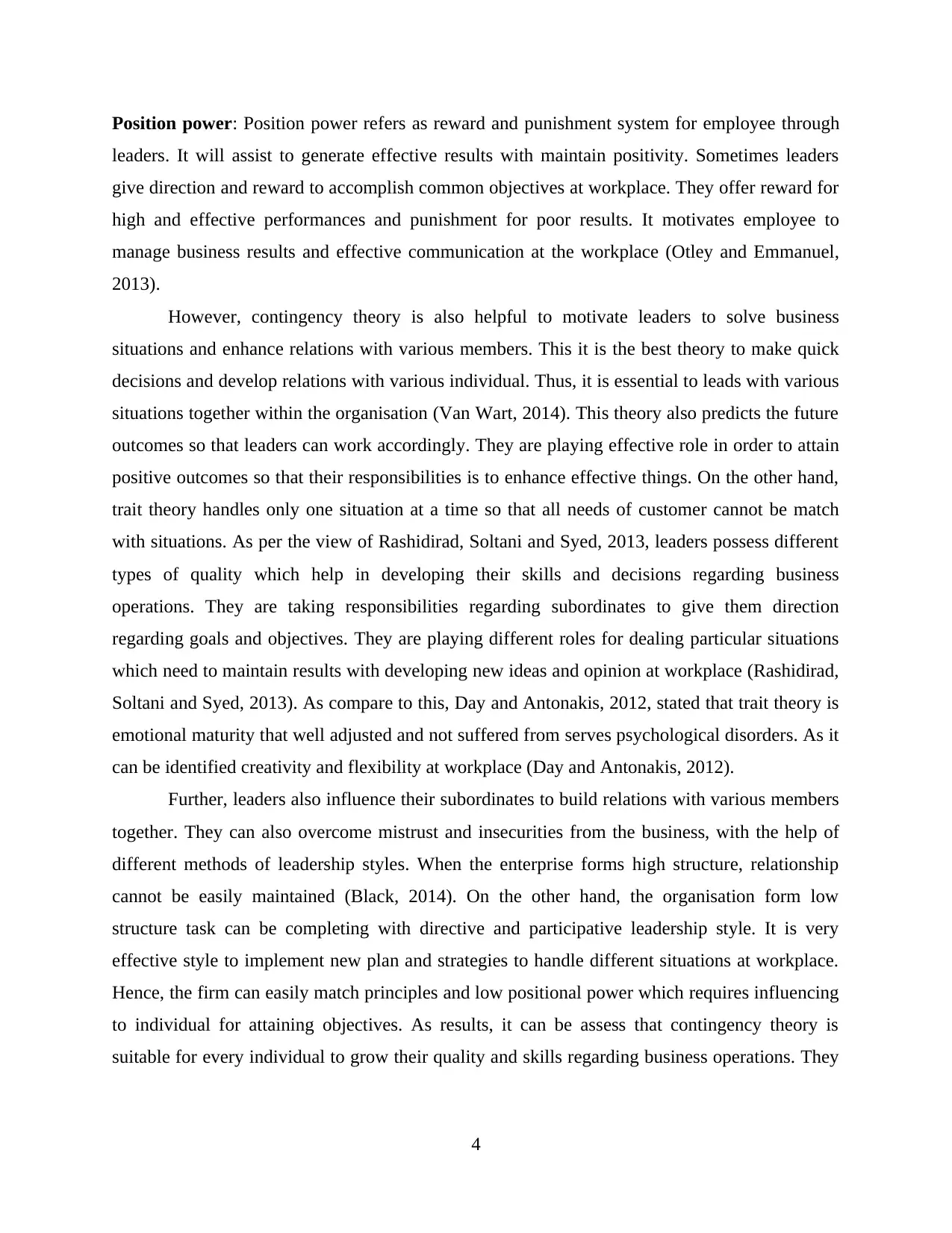
Position power: Position power refers as reward and punishment system for employee through
leaders. It will assist to generate effective results with maintain positivity. Sometimes leaders
give direction and reward to accomplish common objectives at workplace. They offer reward for
high and effective performances and punishment for poor results. It motivates employee to
manage business results and effective communication at the workplace (Otley and Emmanuel,
2013).
However, contingency theory is also helpful to motivate leaders to solve business
situations and enhance relations with various members. This it is the best theory to make quick
decisions and develop relations with various individual. Thus, it is essential to leads with various
situations together within the organisation (Van Wart, 2014). This theory also predicts the future
outcomes so that leaders can work accordingly. They are playing effective role in order to attain
positive outcomes so that their responsibilities is to enhance effective things. On the other hand,
trait theory handles only one situation at a time so that all needs of customer cannot be match
with situations. As per the view of Rashidirad, Soltani and Syed, 2013, leaders possess different
types of quality which help in developing their skills and decisions regarding business
operations. They are taking responsibilities regarding subordinates to give them direction
regarding goals and objectives. They are playing different roles for dealing particular situations
which need to maintain results with developing new ideas and opinion at workplace (Rashidirad,
Soltani and Syed, 2013). As compare to this, Day and Antonakis, 2012, stated that trait theory is
emotional maturity that well adjusted and not suffered from serves psychological disorders. As it
can be identified creativity and flexibility at workplace (Day and Antonakis, 2012).
Further, leaders also influence their subordinates to build relations with various members
together. They can also overcome mistrust and insecurities from the business, with the help of
different methods of leadership styles. When the enterprise forms high structure, relationship
cannot be easily maintained (Black, 2014). On the other hand, the organisation form low
structure task can be completing with directive and participative leadership style. It is very
effective style to implement new plan and strategies to handle different situations at workplace.
Hence, the firm can easily match principles and low positional power which requires influencing
to individual for attaining objectives. As results, it can be assess that contingency theory is
suitable for every individual to grow their quality and skills regarding business operations. They
4
leaders. It will assist to generate effective results with maintain positivity. Sometimes leaders
give direction and reward to accomplish common objectives at workplace. They offer reward for
high and effective performances and punishment for poor results. It motivates employee to
manage business results and effective communication at the workplace (Otley and Emmanuel,
2013).
However, contingency theory is also helpful to motivate leaders to solve business
situations and enhance relations with various members. This it is the best theory to make quick
decisions and develop relations with various individual. Thus, it is essential to leads with various
situations together within the organisation (Van Wart, 2014). This theory also predicts the future
outcomes so that leaders can work accordingly. They are playing effective role in order to attain
positive outcomes so that their responsibilities is to enhance effective things. On the other hand,
trait theory handles only one situation at a time so that all needs of customer cannot be match
with situations. As per the view of Rashidirad, Soltani and Syed, 2013, leaders possess different
types of quality which help in developing their skills and decisions regarding business
operations. They are taking responsibilities regarding subordinates to give them direction
regarding goals and objectives. They are playing different roles for dealing particular situations
which need to maintain results with developing new ideas and opinion at workplace (Rashidirad,
Soltani and Syed, 2013). As compare to this, Day and Antonakis, 2012, stated that trait theory is
emotional maturity that well adjusted and not suffered from serves psychological disorders. As it
can be identified creativity and flexibility at workplace (Day and Antonakis, 2012).
Further, leaders also influence their subordinates to build relations with various members
together. They can also overcome mistrust and insecurities from the business, with the help of
different methods of leadership styles. When the enterprise forms high structure, relationship
cannot be easily maintained (Black, 2014). On the other hand, the organisation form low
structure task can be completing with directive and participative leadership style. It is very
effective style to implement new plan and strategies to handle different situations at workplace.
Hence, the firm can easily match principles and low positional power which requires influencing
to individual for attaining objectives. As results, it can be assess that contingency theory is
suitable for every individual to grow their quality and skills regarding business operations. They
4
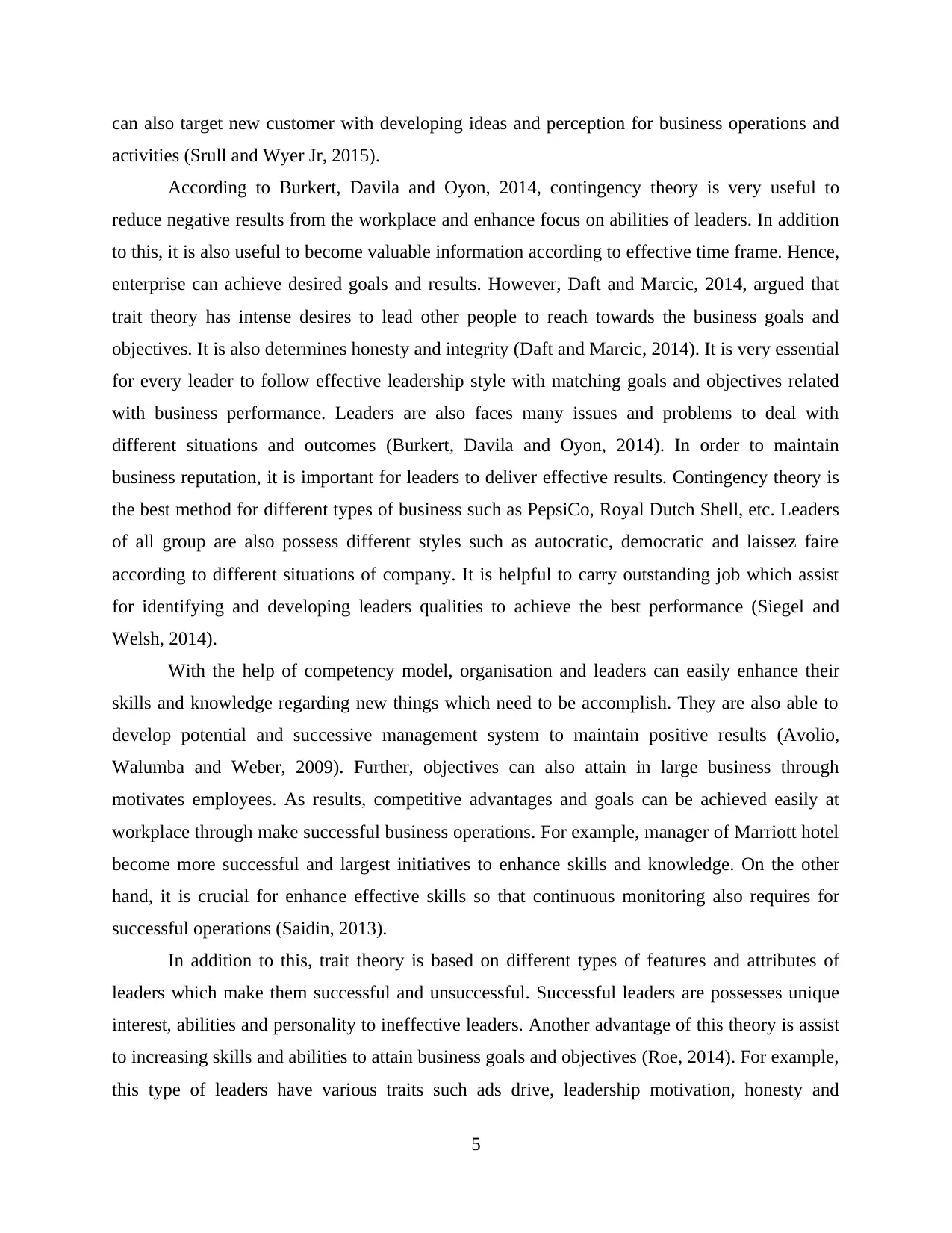
can also target new customer with developing ideas and perception for business operations and
activities (Srull and Wyer Jr, 2015).
According to Burkert, Davila and Oyon, 2014, contingency theory is very useful to
reduce negative results from the workplace and enhance focus on abilities of leaders. In addition
to this, it is also useful to become valuable information according to effective time frame. Hence,
enterprise can achieve desired goals and results. However, Daft and Marcic, 2014, argued that
trait theory has intense desires to lead other people to reach towards the business goals and
objectives. It is also determines honesty and integrity (Daft and Marcic, 2014). It is very essential
for every leader to follow effective leadership style with matching goals and objectives related
with business performance. Leaders are also faces many issues and problems to deal with
different situations and outcomes (Burkert, Davila and Oyon, 2014). In order to maintain
business reputation, it is important for leaders to deliver effective results. Contingency theory is
the best method for different types of business such as PepsiCo, Royal Dutch Shell, etc. Leaders
of all group are also possess different styles such as autocratic, democratic and laissez faire
according to different situations of company. It is helpful to carry outstanding job which assist
for identifying and developing leaders qualities to achieve the best performance (Siegel and
Welsh, 2014).
With the help of competency model, organisation and leaders can easily enhance their
skills and knowledge regarding new things which need to be accomplish. They are also able to
develop potential and successive management system to maintain positive results (Avolio,
Walumba and Weber, 2009). Further, objectives can also attain in large business through
motivates employees. As results, competitive advantages and goals can be achieved easily at
workplace through make successful business operations. For example, manager of Marriott hotel
become more successful and largest initiatives to enhance skills and knowledge. On the other
hand, it is crucial for enhance effective skills so that continuous monitoring also requires for
successful operations (Saidin, 2013).
In addition to this, trait theory is based on different types of features and attributes of
leaders which make them successful and unsuccessful. Successful leaders are possesses unique
interest, abilities and personality to ineffective leaders. Another advantage of this theory is assist
to increasing skills and abilities to attain business goals and objectives (Roe, 2014). For example,
this type of leaders have various traits such ads drive, leadership motivation, honesty and
5
activities (Srull and Wyer Jr, 2015).
According to Burkert, Davila and Oyon, 2014, contingency theory is very useful to
reduce negative results from the workplace and enhance focus on abilities of leaders. In addition
to this, it is also useful to become valuable information according to effective time frame. Hence,
enterprise can achieve desired goals and results. However, Daft and Marcic, 2014, argued that
trait theory has intense desires to lead other people to reach towards the business goals and
objectives. It is also determines honesty and integrity (Daft and Marcic, 2014). It is very essential
for every leader to follow effective leadership style with matching goals and objectives related
with business performance. Leaders are also faces many issues and problems to deal with
different situations and outcomes (Burkert, Davila and Oyon, 2014). In order to maintain
business reputation, it is important for leaders to deliver effective results. Contingency theory is
the best method for different types of business such as PepsiCo, Royal Dutch Shell, etc. Leaders
of all group are also possess different styles such as autocratic, democratic and laissez faire
according to different situations of company. It is helpful to carry outstanding job which assist
for identifying and developing leaders qualities to achieve the best performance (Siegel and
Welsh, 2014).
With the help of competency model, organisation and leaders can easily enhance their
skills and knowledge regarding new things which need to be accomplish. They are also able to
develop potential and successive management system to maintain positive results (Avolio,
Walumba and Weber, 2009). Further, objectives can also attain in large business through
motivates employees. As results, competitive advantages and goals can be achieved easily at
workplace through make successful business operations. For example, manager of Marriott hotel
become more successful and largest initiatives to enhance skills and knowledge. On the other
hand, it is crucial for enhance effective skills so that continuous monitoring also requires for
successful operations (Saidin, 2013).
In addition to this, trait theory is based on different types of features and attributes of
leaders which make them successful and unsuccessful. Successful leaders are possesses unique
interest, abilities and personality to ineffective leaders. Another advantage of this theory is assist
to increasing skills and abilities to attain business goals and objectives (Roe, 2014). For example,
this type of leaders have various traits such ads drive, leadership motivation, honesty and
5
⊘ This is a preview!⊘
Do you want full access?
Subscribe today to unlock all pages.

Trusted by 1+ million students worldwide
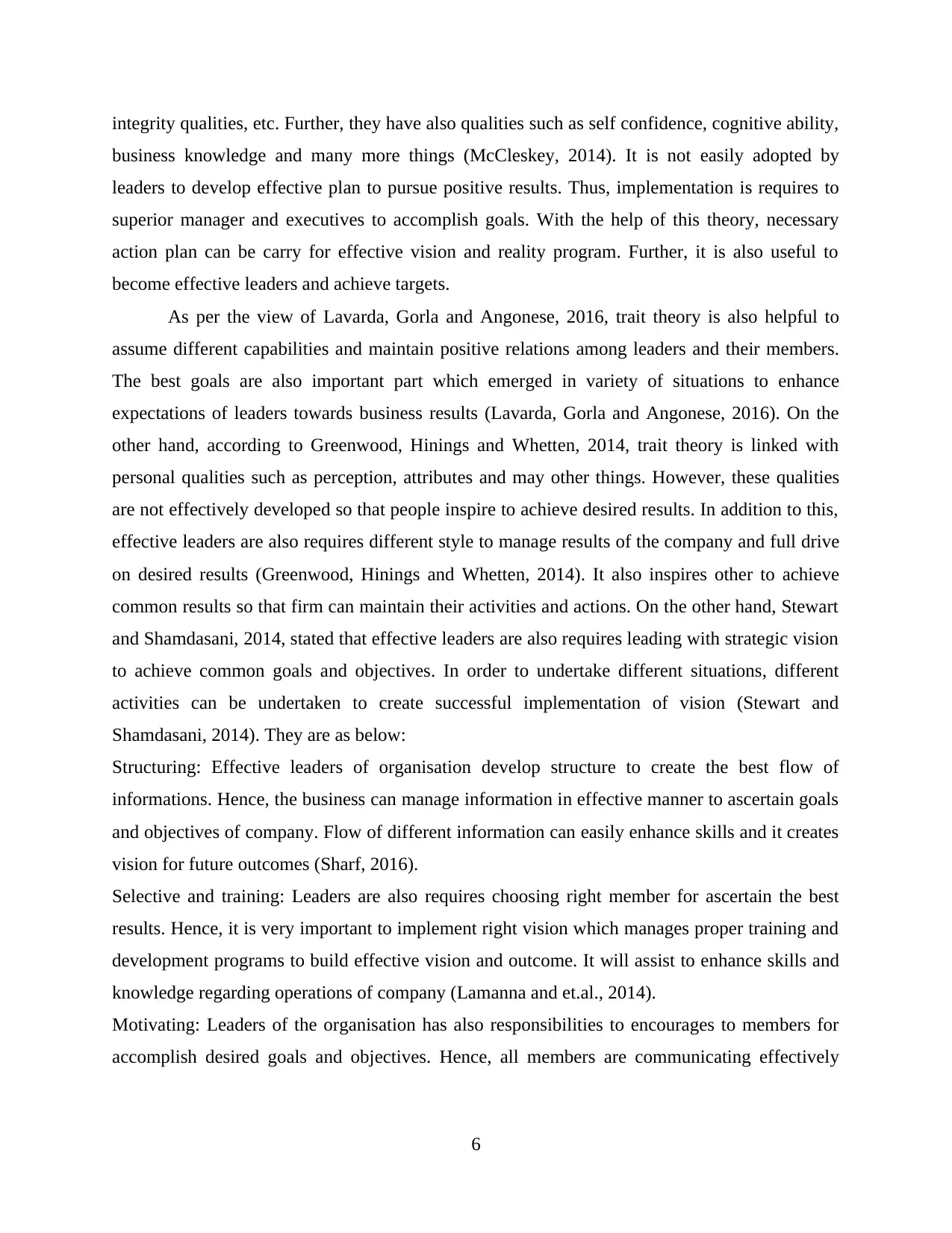
integrity qualities, etc. Further, they have also qualities such as self confidence, cognitive ability,
business knowledge and many more things (McCleskey, 2014). It is not easily adopted by
leaders to develop effective plan to pursue positive results. Thus, implementation is requires to
superior manager and executives to accomplish goals. With the help of this theory, necessary
action plan can be carry for effective vision and reality program. Further, it is also useful to
become effective leaders and achieve targets.
As per the view of Lavarda, Gorla and Angonese, 2016, trait theory is also helpful to
assume different capabilities and maintain positive relations among leaders and their members.
The best goals are also important part which emerged in variety of situations to enhance
expectations of leaders towards business results (Lavarda, Gorla and Angonese, 2016). On the
other hand, according to Greenwood, Hinings and Whetten, 2014, trait theory is linked with
personal qualities such as perception, attributes and may other things. However, these qualities
are not effectively developed so that people inspire to achieve desired results. In addition to this,
effective leaders are also requires different style to manage results of the company and full drive
on desired results (Greenwood, Hinings and Whetten, 2014). It also inspires other to achieve
common results so that firm can maintain their activities and actions. On the other hand, Stewart
and Shamdasani, 2014, stated that effective leaders are also requires leading with strategic vision
to achieve common goals and objectives. In order to undertake different situations, different
activities can be undertaken to create successful implementation of vision (Stewart and
Shamdasani, 2014). They are as below:
Structuring: Effective leaders of organisation develop structure to create the best flow of
informations. Hence, the business can manage information in effective manner to ascertain goals
and objectives of company. Flow of different information can easily enhance skills and it creates
vision for future outcomes (Sharf, 2016).
Selective and training: Leaders are also requires choosing right member for ascertain the best
results. Hence, it is very important to implement right vision which manages proper training and
development programs to build effective vision and outcome. It will assist to enhance skills and
knowledge regarding operations of company (Lamanna and et.al., 2014).
Motivating: Leaders of the organisation has also responsibilities to encourages to members for
accomplish desired goals and objectives. Hence, all members are communicating effectively
6
business knowledge and many more things (McCleskey, 2014). It is not easily adopted by
leaders to develop effective plan to pursue positive results. Thus, implementation is requires to
superior manager and executives to accomplish goals. With the help of this theory, necessary
action plan can be carry for effective vision and reality program. Further, it is also useful to
become effective leaders and achieve targets.
As per the view of Lavarda, Gorla and Angonese, 2016, trait theory is also helpful to
assume different capabilities and maintain positive relations among leaders and their members.
The best goals are also important part which emerged in variety of situations to enhance
expectations of leaders towards business results (Lavarda, Gorla and Angonese, 2016). On the
other hand, according to Greenwood, Hinings and Whetten, 2014, trait theory is linked with
personal qualities such as perception, attributes and may other things. However, these qualities
are not effectively developed so that people inspire to achieve desired results. In addition to this,
effective leaders are also requires different style to manage results of the company and full drive
on desired results (Greenwood, Hinings and Whetten, 2014). It also inspires other to achieve
common results so that firm can maintain their activities and actions. On the other hand, Stewart
and Shamdasani, 2014, stated that effective leaders are also requires leading with strategic vision
to achieve common goals and objectives. In order to undertake different situations, different
activities can be undertaken to create successful implementation of vision (Stewart and
Shamdasani, 2014). They are as below:
Structuring: Effective leaders of organisation develop structure to create the best flow of
informations. Hence, the business can manage information in effective manner to ascertain goals
and objectives of company. Flow of different information can easily enhance skills and it creates
vision for future outcomes (Sharf, 2016).
Selective and training: Leaders are also requires choosing right member for ascertain the best
results. Hence, it is very important to implement right vision which manages proper training and
development programs to build effective vision and outcome. It will assist to enhance skills and
knowledge regarding operations of company (Lamanna and et.al., 2014).
Motivating: Leaders of the organisation has also responsibilities to encourages to members for
accomplish desired goals and objectives. Hence, all members are communicating effectively
6
Paraphrase This Document
Need a fresh take? Get an instant paraphrase of this document with our AI Paraphraser
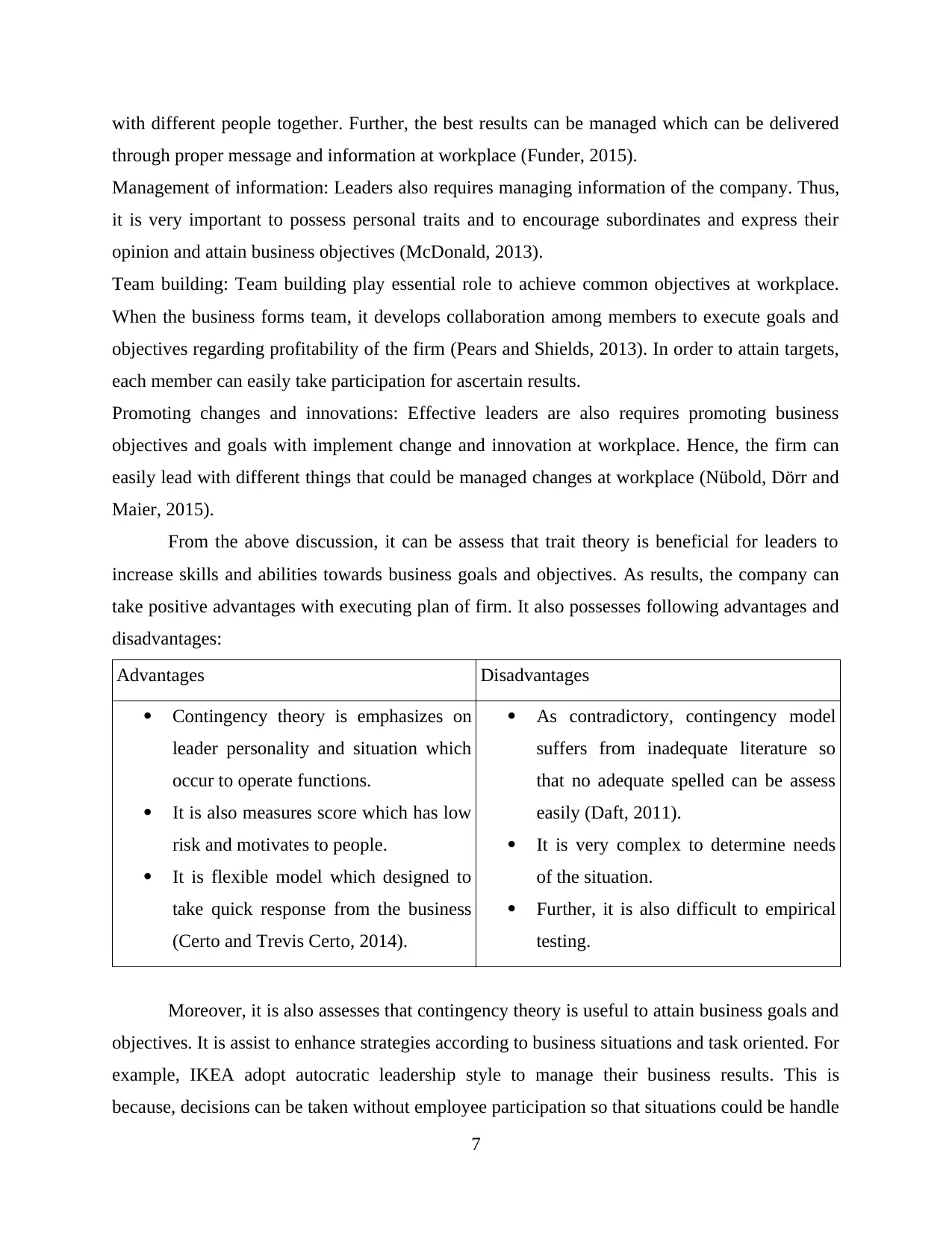
with different people together. Further, the best results can be managed which can be delivered
through proper message and information at workplace (Funder, 2015).
Management of information: Leaders also requires managing information of the company. Thus,
it is very important to possess personal traits and to encourage subordinates and express their
opinion and attain business objectives (McDonald, 2013).
Team building: Team building play essential role to achieve common objectives at workplace.
When the business forms team, it develops collaboration among members to execute goals and
objectives regarding profitability of the firm (Pears and Shields, 2013). In order to attain targets,
each member can easily take participation for ascertain results.
Promoting changes and innovations: Effective leaders are also requires promoting business
objectives and goals with implement change and innovation at workplace. Hence, the firm can
easily lead with different things that could be managed changes at workplace (Nübold, Dörr and
Maier, 2015).
From the above discussion, it can be assess that trait theory is beneficial for leaders to
increase skills and abilities towards business goals and objectives. As results, the company can
take positive advantages with executing plan of firm. It also possesses following advantages and
disadvantages:
Advantages Disadvantages
Contingency theory is emphasizes on
leader personality and situation which
occur to operate functions.
It is also measures score which has low
risk and motivates to people.
It is flexible model which designed to
take quick response from the business
(Certo and Trevis Certo, 2014).
As contradictory, contingency model
suffers from inadequate literature so
that no adequate spelled can be assess
easily (Daft, 2011).
It is very complex to determine needs
of the situation.
Further, it is also difficult to empirical
testing.
Moreover, it is also assesses that contingency theory is useful to attain business goals and
objectives. It is assist to enhance strategies according to business situations and task oriented. For
example, IKEA adopt autocratic leadership style to manage their business results. This is
because, decisions can be taken without employee participation so that situations could be handle
7
through proper message and information at workplace (Funder, 2015).
Management of information: Leaders also requires managing information of the company. Thus,
it is very important to possess personal traits and to encourage subordinates and express their
opinion and attain business objectives (McDonald, 2013).
Team building: Team building play essential role to achieve common objectives at workplace.
When the business forms team, it develops collaboration among members to execute goals and
objectives regarding profitability of the firm (Pears and Shields, 2013). In order to attain targets,
each member can easily take participation for ascertain results.
Promoting changes and innovations: Effective leaders are also requires promoting business
objectives and goals with implement change and innovation at workplace. Hence, the firm can
easily lead with different things that could be managed changes at workplace (Nübold, Dörr and
Maier, 2015).
From the above discussion, it can be assess that trait theory is beneficial for leaders to
increase skills and abilities towards business goals and objectives. As results, the company can
take positive advantages with executing plan of firm. It also possesses following advantages and
disadvantages:
Advantages Disadvantages
Contingency theory is emphasizes on
leader personality and situation which
occur to operate functions.
It is also measures score which has low
risk and motivates to people.
It is flexible model which designed to
take quick response from the business
(Certo and Trevis Certo, 2014).
As contradictory, contingency model
suffers from inadequate literature so
that no adequate spelled can be assess
easily (Daft, 2011).
It is very complex to determine needs
of the situation.
Further, it is also difficult to empirical
testing.
Moreover, it is also assesses that contingency theory is useful to attain business goals and
objectives. It is assist to enhance strategies according to business situations and task oriented. For
example, IKEA adopt autocratic leadership style to manage their business results. This is
because, decisions can be taken without employee participation so that situations could be handle
7
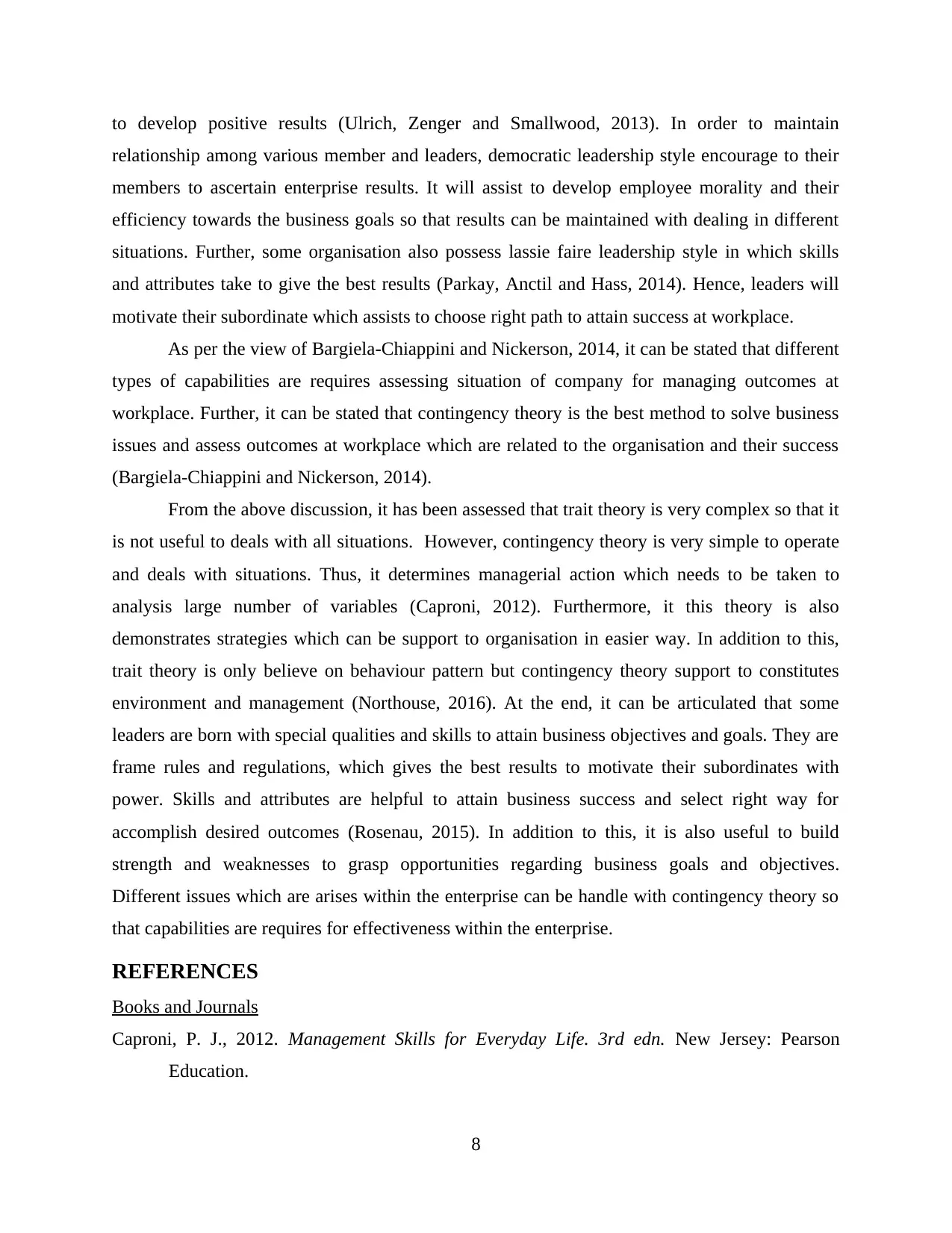
to develop positive results (Ulrich, Zenger and Smallwood, 2013). In order to maintain
relationship among various member and leaders, democratic leadership style encourage to their
members to ascertain enterprise results. It will assist to develop employee morality and their
efficiency towards the business goals so that results can be maintained with dealing in different
situations. Further, some organisation also possess lassie faire leadership style in which skills
and attributes take to give the best results (Parkay, Anctil and Hass, 2014). Hence, leaders will
motivate their subordinate which assists to choose right path to attain success at workplace.
As per the view of Bargiela-Chiappini and Nickerson, 2014, it can be stated that different
types of capabilities are requires assessing situation of company for managing outcomes at
workplace. Further, it can be stated that contingency theory is the best method to solve business
issues and assess outcomes at workplace which are related to the organisation and their success
(Bargiela-Chiappini and Nickerson, 2014).
From the above discussion, it has been assessed that trait theory is very complex so that it
is not useful to deals with all situations. However, contingency theory is very simple to operate
and deals with situations. Thus, it determines managerial action which needs to be taken to
analysis large number of variables (Caproni, 2012). Furthermore, it this theory is also
demonstrates strategies which can be support to organisation in easier way. In addition to this,
trait theory is only believe on behaviour pattern but contingency theory support to constitutes
environment and management (Northouse, 2016). At the end, it can be articulated that some
leaders are born with special qualities and skills to attain business objectives and goals. They are
frame rules and regulations, which gives the best results to motivate their subordinates with
power. Skills and attributes are helpful to attain business success and select right way for
accomplish desired outcomes (Rosenau, 2015). In addition to this, it is also useful to build
strength and weaknesses to grasp opportunities regarding business goals and objectives.
Different issues which are arises within the enterprise can be handle with contingency theory so
that capabilities are requires for effectiveness within the enterprise.
REFERENCES
Books and Journals
Caproni, P. J., 2012. Management Skills for Everyday Life. 3rd edn. New Jersey: Pearson
Education.
8
relationship among various member and leaders, democratic leadership style encourage to their
members to ascertain enterprise results. It will assist to develop employee morality and their
efficiency towards the business goals so that results can be maintained with dealing in different
situations. Further, some organisation also possess lassie faire leadership style in which skills
and attributes take to give the best results (Parkay, Anctil and Hass, 2014). Hence, leaders will
motivate their subordinate which assists to choose right path to attain success at workplace.
As per the view of Bargiela-Chiappini and Nickerson, 2014, it can be stated that different
types of capabilities are requires assessing situation of company for managing outcomes at
workplace. Further, it can be stated that contingency theory is the best method to solve business
issues and assess outcomes at workplace which are related to the organisation and their success
(Bargiela-Chiappini and Nickerson, 2014).
From the above discussion, it has been assessed that trait theory is very complex so that it
is not useful to deals with all situations. However, contingency theory is very simple to operate
and deals with situations. Thus, it determines managerial action which needs to be taken to
analysis large number of variables (Caproni, 2012). Furthermore, it this theory is also
demonstrates strategies which can be support to organisation in easier way. In addition to this,
trait theory is only believe on behaviour pattern but contingency theory support to constitutes
environment and management (Northouse, 2016). At the end, it can be articulated that some
leaders are born with special qualities and skills to attain business objectives and goals. They are
frame rules and regulations, which gives the best results to motivate their subordinates with
power. Skills and attributes are helpful to attain business success and select right way for
accomplish desired outcomes (Rosenau, 2015). In addition to this, it is also useful to build
strength and weaknesses to grasp opportunities regarding business goals and objectives.
Different issues which are arises within the enterprise can be handle with contingency theory so
that capabilities are requires for effectiveness within the enterprise.
REFERENCES
Books and Journals
Caproni, P. J., 2012. Management Skills for Everyday Life. 3rd edn. New Jersey: Pearson
Education.
8
⊘ This is a preview!⊘
Do you want full access?
Subscribe today to unlock all pages.

Trusted by 1+ million students worldwide
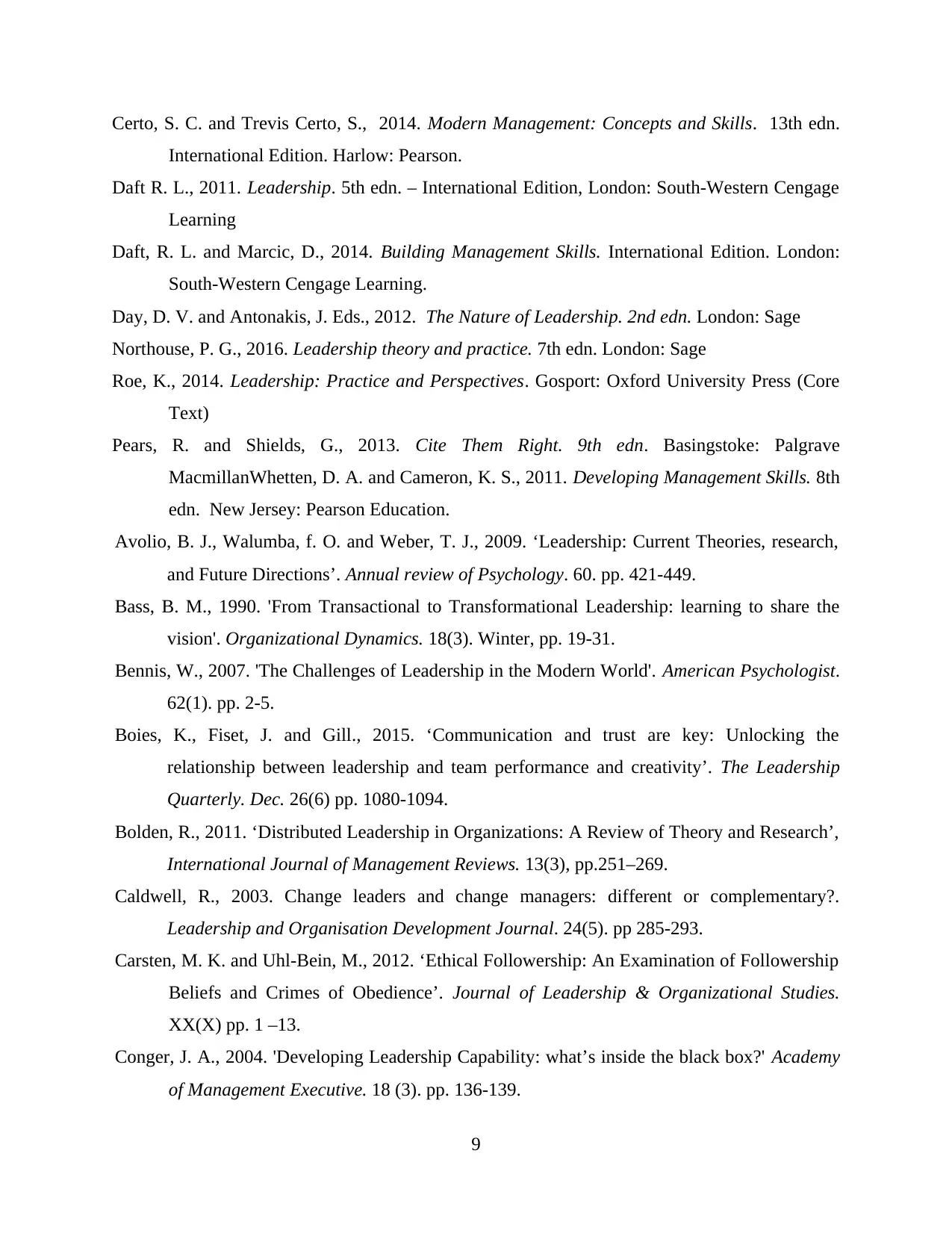
Certo, S. C. and Trevis Certo, S., 2014. Modern Management: Concepts and Skills. 13th edn.
International Edition. Harlow: Pearson.
Daft R. L., 2011. Leadership. 5th edn. – International Edition, London: South-Western Cengage
Learning
Daft, R. L. and Marcic, D., 2014. Building Management Skills. International Edition. London:
South-Western Cengage Learning.
Day, D. V. and Antonakis, J. Eds., 2012. The Nature of Leadership. 2nd edn. London: Sage
Northouse, P. G., 2016. Leadership theory and practice. 7th edn. London: Sage
Roe, K., 2014. Leadership: Practice and Perspectives. Gosport: Oxford University Press (Core
Text)
Pears, R. and Shields, G., 2013. Cite Them Right. 9th edn. Basingstoke: Palgrave
MacmillanWhetten, D. A. and Cameron, K. S., 2011. Developing Management Skills. 8th
edn. New Jersey: Pearson Education.
Avolio, B. J., Walumba, f. O. and Weber, T. J., 2009. ‘Leadership: Current Theories, research,
and Future Directions’. Annual review of Psychology. 60. pp. 421-449.
Bass, B. M., 1990. 'From Transactional to Transformational Leadership: learning to share the
vision'. Organizational Dynamics. 18(3). Winter, pp. 19-31.
Bennis, W., 2007. 'The Challenges of Leadership in the Modern World'. American Psychologist.
62(1). pp. 2-5.
Boies, K., Fiset, J. and Gill., 2015. ‘Communication and trust are key: Unlocking the
relationship between leadership and team performance and creativity’. The Leadership
Quarterly. Dec. 26(6) pp. 1080-1094.
Bolden, R., 2011. ‘Distributed Leadership in Organizations: A Review of Theory and Research’,
International Journal of Management Reviews. 13(3), pp.251–269.
Caldwell, R., 2003. Change leaders and change managers: different or complementary?.
Leadership and Organisation Development Journal. 24(5). pp 285-293.
Carsten, M. K. and Uhl-Bein, M., 2012. ‘Ethical Followership: An Examination of Followership
Beliefs and Crimes of Obedience’. Journal of Leadership & Organizational Studies.
XX(X) pp. 1 –13.
Conger, J. A., 2004. 'Developing Leadership Capability: what’s inside the black box?' Academy
of Management Executive. 18 (3). pp. 136-139.
9
International Edition. Harlow: Pearson.
Daft R. L., 2011. Leadership. 5th edn. – International Edition, London: South-Western Cengage
Learning
Daft, R. L. and Marcic, D., 2014. Building Management Skills. International Edition. London:
South-Western Cengage Learning.
Day, D. V. and Antonakis, J. Eds., 2012. The Nature of Leadership. 2nd edn. London: Sage
Northouse, P. G., 2016. Leadership theory and practice. 7th edn. London: Sage
Roe, K., 2014. Leadership: Practice and Perspectives. Gosport: Oxford University Press (Core
Text)
Pears, R. and Shields, G., 2013. Cite Them Right. 9th edn. Basingstoke: Palgrave
MacmillanWhetten, D. A. and Cameron, K. S., 2011. Developing Management Skills. 8th
edn. New Jersey: Pearson Education.
Avolio, B. J., Walumba, f. O. and Weber, T. J., 2009. ‘Leadership: Current Theories, research,
and Future Directions’. Annual review of Psychology. 60. pp. 421-449.
Bass, B. M., 1990. 'From Transactional to Transformational Leadership: learning to share the
vision'. Organizational Dynamics. 18(3). Winter, pp. 19-31.
Bennis, W., 2007. 'The Challenges of Leadership in the Modern World'. American Psychologist.
62(1). pp. 2-5.
Boies, K., Fiset, J. and Gill., 2015. ‘Communication and trust are key: Unlocking the
relationship between leadership and team performance and creativity’. The Leadership
Quarterly. Dec. 26(6) pp. 1080-1094.
Bolden, R., 2011. ‘Distributed Leadership in Organizations: A Review of Theory and Research’,
International Journal of Management Reviews. 13(3), pp.251–269.
Caldwell, R., 2003. Change leaders and change managers: different or complementary?.
Leadership and Organisation Development Journal. 24(5). pp 285-293.
Carsten, M. K. and Uhl-Bein, M., 2012. ‘Ethical Followership: An Examination of Followership
Beliefs and Crimes of Obedience’. Journal of Leadership & Organizational Studies.
XX(X) pp. 1 –13.
Conger, J. A., 2004. 'Developing Leadership Capability: what’s inside the black box?' Academy
of Management Executive. 18 (3). pp. 136-139.
9
Paraphrase This Document
Need a fresh take? Get an instant paraphrase of this document with our AI Paraphraser
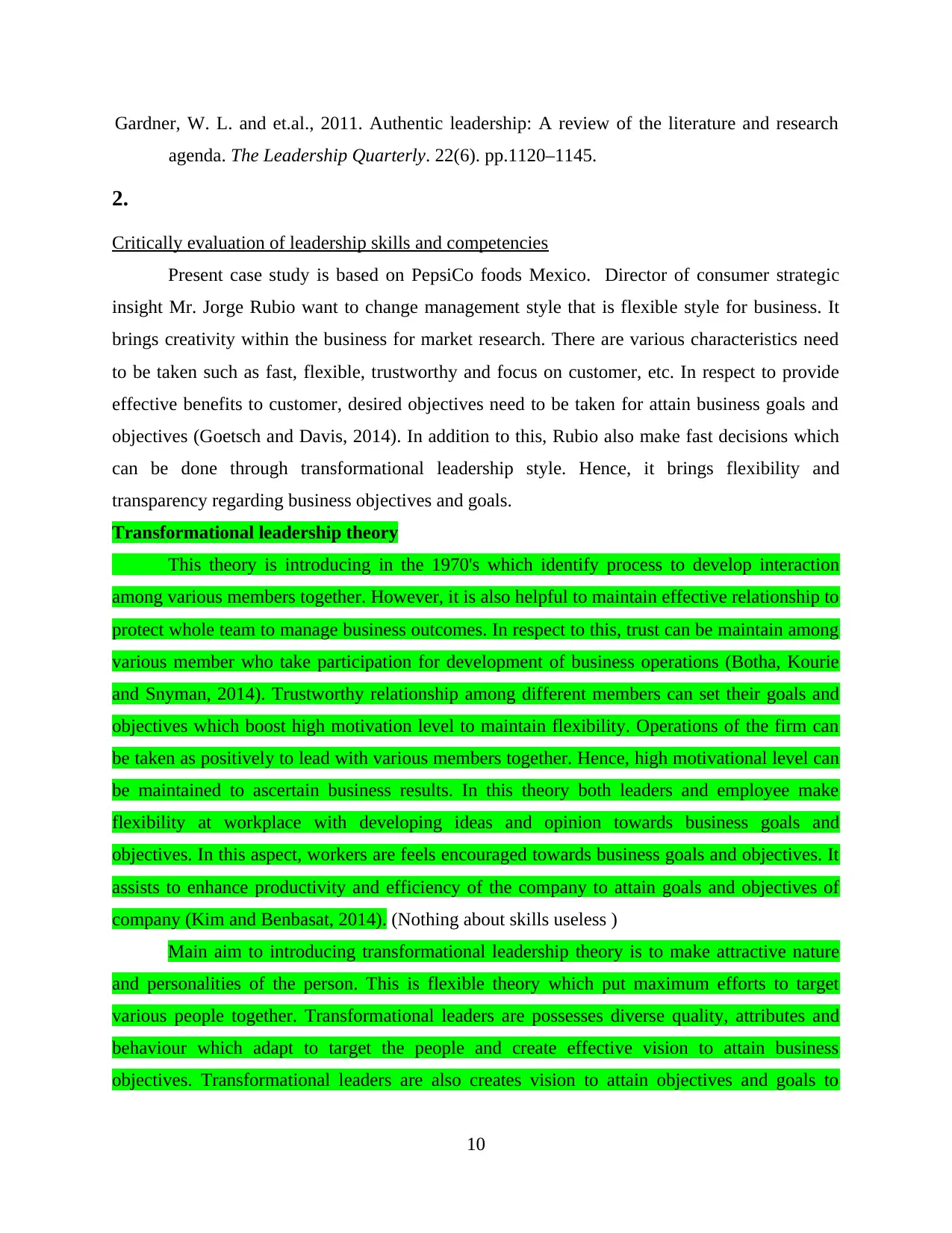
Gardner, W. L. and et.al., 2011. Authentic leadership: A review of the literature and research
agenda. The Leadership Quarterly. 22(6). pp.1120–1145.
2.
Critically evaluation of leadership skills and competencies
Present case study is based on PepsiCo foods Mexico. Director of consumer strategic
insight Mr. Jorge Rubio want to change management style that is flexible style for business. It
brings creativity within the business for market research. There are various characteristics need
to be taken such as fast, flexible, trustworthy and focus on customer, etc. In respect to provide
effective benefits to customer, desired objectives need to be taken for attain business goals and
objectives (Goetsch and Davis, 2014). In addition to this, Rubio also make fast decisions which
can be done through transformational leadership style. Hence, it brings flexibility and
transparency regarding business objectives and goals.
Transformational leadership theory
This theory is introducing in the 1970's which identify process to develop interaction
among various members together. However, it is also helpful to maintain effective relationship to
protect whole team to manage business outcomes. In respect to this, trust can be maintain among
various member who take participation for development of business operations (Botha, Kourie
and Snyman, 2014). Trustworthy relationship among different members can set their goals and
objectives which boost high motivation level to maintain flexibility. Operations of the firm can
be taken as positively to lead with various members together. Hence, high motivational level can
be maintained to ascertain business results. In this theory both leaders and employee make
flexibility at workplace with developing ideas and opinion towards business goals and
objectives. In this aspect, workers are feels encouraged towards business goals and objectives. It
assists to enhance productivity and efficiency of the company to attain goals and objectives of
company (Kim and Benbasat, 2014). (Nothing about skills useless )
Main aim to introducing transformational leadership theory is to make attractive nature
and personalities of the person. This is flexible theory which put maximum efforts to target
various people together. Transformational leaders are possesses diverse quality, attributes and
behaviour which adapt to target the people and create effective vision to attain business
objectives. Transformational leaders are also creates vision to attain objectives and goals to
10
agenda. The Leadership Quarterly. 22(6). pp.1120–1145.
2.
Critically evaluation of leadership skills and competencies
Present case study is based on PepsiCo foods Mexico. Director of consumer strategic
insight Mr. Jorge Rubio want to change management style that is flexible style for business. It
brings creativity within the business for market research. There are various characteristics need
to be taken such as fast, flexible, trustworthy and focus on customer, etc. In respect to provide
effective benefits to customer, desired objectives need to be taken for attain business goals and
objectives (Goetsch and Davis, 2014). In addition to this, Rubio also make fast decisions which
can be done through transformational leadership style. Hence, it brings flexibility and
transparency regarding business objectives and goals.
Transformational leadership theory
This theory is introducing in the 1970's which identify process to develop interaction
among various members together. However, it is also helpful to maintain effective relationship to
protect whole team to manage business outcomes. In respect to this, trust can be maintain among
various member who take participation for development of business operations (Botha, Kourie
and Snyman, 2014). Trustworthy relationship among different members can set their goals and
objectives which boost high motivation level to maintain flexibility. Operations of the firm can
be taken as positively to lead with various members together. Hence, high motivational level can
be maintained to ascertain business results. In this theory both leaders and employee make
flexibility at workplace with developing ideas and opinion towards business goals and
objectives. In this aspect, workers are feels encouraged towards business goals and objectives. It
assists to enhance productivity and efficiency of the company to attain goals and objectives of
company (Kim and Benbasat, 2014). (Nothing about skills useless )
Main aim to introducing transformational leadership theory is to make attractive nature
and personalities of the person. This is flexible theory which put maximum efforts to target
various people together. Transformational leaders are possesses diverse quality, attributes and
behaviour which adapt to target the people and create effective vision to attain business
objectives. Transformational leaders are also creates vision to attain objectives and goals to
10
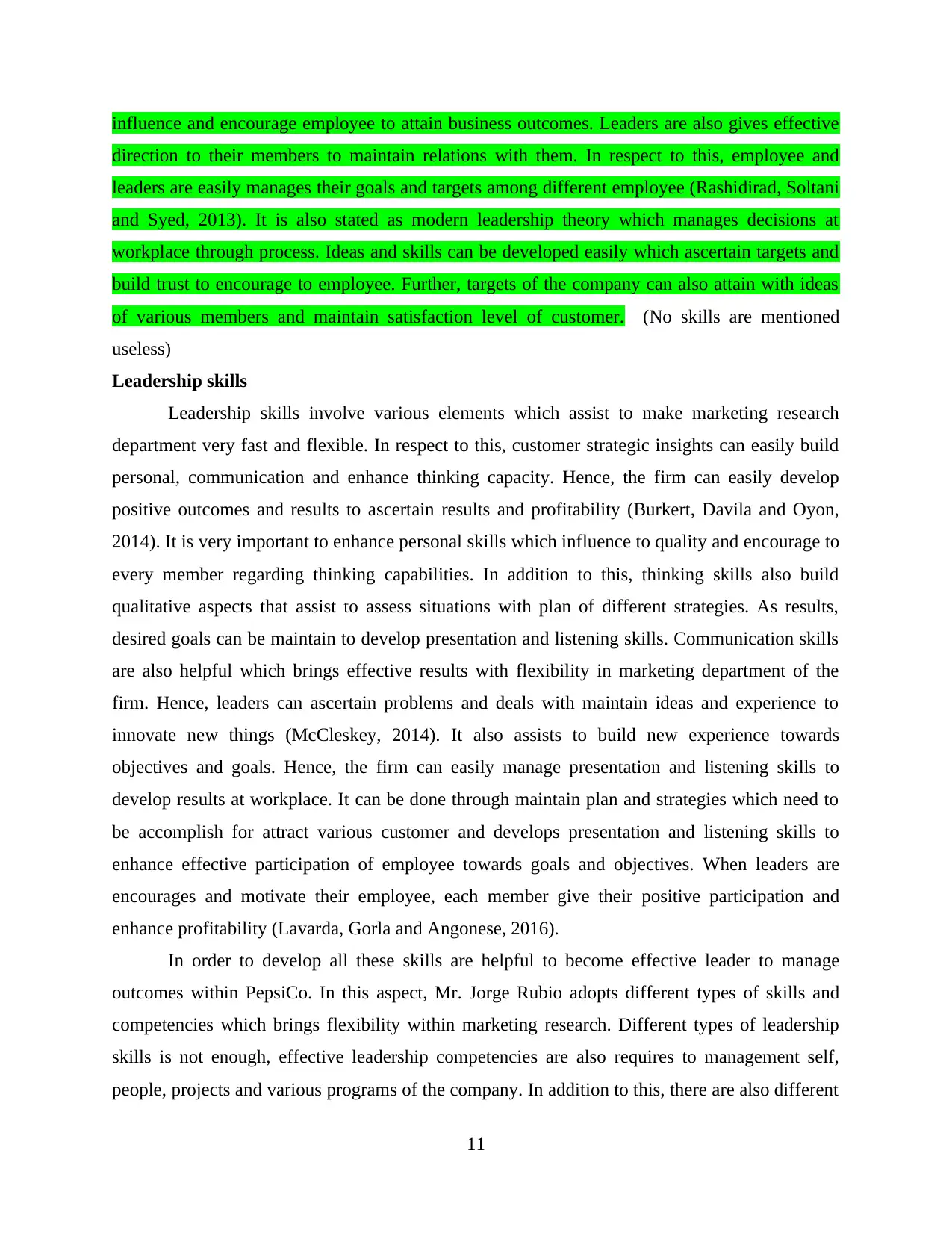
influence and encourage employee to attain business outcomes. Leaders are also gives effective
direction to their members to maintain relations with them. In respect to this, employee and
leaders are easily manages their goals and targets among different employee (Rashidirad, Soltani
and Syed, 2013). It is also stated as modern leadership theory which manages decisions at
workplace through process. Ideas and skills can be developed easily which ascertain targets and
build trust to encourage to employee. Further, targets of the company can also attain with ideas
of various members and maintain satisfaction level of customer. (No skills are mentioned
useless)
Leadership skills
Leadership skills involve various elements which assist to make marketing research
department very fast and flexible. In respect to this, customer strategic insights can easily build
personal, communication and enhance thinking capacity. Hence, the firm can easily develop
positive outcomes and results to ascertain results and profitability (Burkert, Davila and Oyon,
2014). It is very important to enhance personal skills which influence to quality and encourage to
every member regarding thinking capabilities. In addition to this, thinking skills also build
qualitative aspects that assist to assess situations with plan of different strategies. As results,
desired goals can be maintain to develop presentation and listening skills. Communication skills
are also helpful which brings effective results with flexibility in marketing department of the
firm. Hence, leaders can ascertain problems and deals with maintain ideas and experience to
innovate new things (McCleskey, 2014). It also assists to build new experience towards
objectives and goals. Hence, the firm can easily manage presentation and listening skills to
develop results at workplace. It can be done through maintain plan and strategies which need to
be accomplish for attract various customer and develops presentation and listening skills to
enhance effective participation of employee towards goals and objectives. When leaders are
encourages and motivate their employee, each member give their positive participation and
enhance profitability (Lavarda, Gorla and Angonese, 2016).
In order to develop all these skills are helpful to become effective leader to manage
outcomes within PepsiCo. In this aspect, Mr. Jorge Rubio adopts different types of skills and
competencies which brings flexibility within marketing research. Different types of leadership
skills is not enough, effective leadership competencies are also requires to management self,
people, projects and various programs of the company. In addition to this, there are also different
11
direction to their members to maintain relations with them. In respect to this, employee and
leaders are easily manages their goals and targets among different employee (Rashidirad, Soltani
and Syed, 2013). It is also stated as modern leadership theory which manages decisions at
workplace through process. Ideas and skills can be developed easily which ascertain targets and
build trust to encourage to employee. Further, targets of the company can also attain with ideas
of various members and maintain satisfaction level of customer. (No skills are mentioned
useless)
Leadership skills
Leadership skills involve various elements which assist to make marketing research
department very fast and flexible. In respect to this, customer strategic insights can easily build
personal, communication and enhance thinking capacity. Hence, the firm can easily develop
positive outcomes and results to ascertain results and profitability (Burkert, Davila and Oyon,
2014). It is very important to enhance personal skills which influence to quality and encourage to
every member regarding thinking capabilities. In addition to this, thinking skills also build
qualitative aspects that assist to assess situations with plan of different strategies. As results,
desired goals can be maintain to develop presentation and listening skills. Communication skills
are also helpful which brings effective results with flexibility in marketing department of the
firm. Hence, leaders can ascertain problems and deals with maintain ideas and experience to
innovate new things (McCleskey, 2014). It also assists to build new experience towards
objectives and goals. Hence, the firm can easily manage presentation and listening skills to
develop results at workplace. It can be done through maintain plan and strategies which need to
be accomplish for attract various customer and develops presentation and listening skills to
enhance effective participation of employee towards goals and objectives. When leaders are
encourages and motivate their employee, each member give their positive participation and
enhance profitability (Lavarda, Gorla and Angonese, 2016).
In order to develop all these skills are helpful to become effective leader to manage
outcomes within PepsiCo. In this aspect, Mr. Jorge Rubio adopts different types of skills and
competencies which brings flexibility within marketing research. Different types of leadership
skills is not enough, effective leadership competencies are also requires to management self,
people, projects and various programs of the company. In addition to this, there are also different
11
⊘ This is a preview!⊘
Do you want full access?
Subscribe today to unlock all pages.

Trusted by 1+ million students worldwide
1 out of 21
Related Documents
Your All-in-One AI-Powered Toolkit for Academic Success.
+13062052269
info@desklib.com
Available 24*7 on WhatsApp / Email
![[object Object]](/_next/static/media/star-bottom.7253800d.svg)
Unlock your academic potential
Copyright © 2020–2025 A2Z Services. All Rights Reserved. Developed and managed by ZUCOL.




